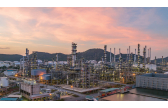
In August 2025, development of the Revolution Wind project off the Rhode Island coast came to a halt with a stop work order issued by the Bureau of Ocean Energy Management (BOEM). If this project were to be completed, the wind farm would have provided over 700 MW of sustainable wind energy for Rhode Island and Connecticut. At the time production halted, the project was 80% complete, with 45 out of 65 turbines already installed (1).
The initial reaction from state lawmakers and the companies behind the project — Danish firm Ørsted and German wind developer Skyborn Renewables — was confusion, with state officials calling the act “bizarre.” The stop work order offered little clarification, as it cited no legal justifications for the action, only that the BOEM was seeking to address national security concerns (1). This led the affected states and companies to file separate lawsuits, and on Sept. 22, a federal judge lifted the halt on the project, allowing construction to resume. Although this project is slated to be fully operational in 2026, the future of the American wind energy industry as a whole remains uncertain.
Wind energy’s place in today’s landscape
In the U.S. today, wind energy comprises 10% of our total energy portfolio. In 2024, combined wind and solar energy output surpassed that of coal for the first time (2). In many parts of the country, wind energy is far more readily visible than hydroelectric, solar, or geothermal energy, and as a result, the iconic white, tri-rotor wind turbine has become a ubiquitous symbol of the energy transition. If a wind turbine is printed on a product’s label, it is conveying that the product was made sustainably. When we at CEP include an image of a wind turbine in an article, it indicates that the article is about sustainability, even if it doesn’t mention wind specifically. Still, the constant nature of this symbol might itself present a problem.
Humans have been using windmills to harness energy for over a thousand years, but the recognizable tri-rotor turbine design didn’t really come about until the 1970s oil embargo prompted NASA scientists to develop existing prototypes into commercially scalable technologies. Those who are skeptical of renewable energy investment may see wind energy’s enduring status as evidence that the technology is stale, static, or archaic. But that line of thinking runs counter to the industry’s latest innovations. This column lays out just a few.
New directions in turbine innovation
Bigger and better design
Despite wind turbines’ aesthetic consistency, their productive capacity has been steadily increasing for the last 25 years, hitting an average 2.5 MW capacity in 2016 (3), with some offshore technologies achieving far higher. Modern computational techniques, manufacturing capabilities, and materials have helped optimize nearly all aspects of the turbine’s design.

Engineers have long sought to create larger rotors to increase energy capacity, but the size of turbine rotors has historically been limited by the maximum dimensions transportable by semi-truck. To get around this, engineers working at the Oak Ridge National Laboratory’s Big Area Additive Manufacturing (BAAM) project have used modular additive manufacturing technologies to “print” components on-site, surpassing past size limitations (3). Turbine heights have also increased, growing from an average of around 60 m to over 100 m today.
In other cases, public-private partnerships have yielded design improvements with significant impacts on turbine performance. For example, the Knight and Carver Wind Group and Sandia National Laboratories used extensive fluid dynamics modeling techniques to create the Sweep Twist Adaptive Rotor (STAR), a blade that is lighter and longer than previous models, capable of harnessing energy even at slow wind speeds, and produces an energy increase of 12%.
Under the hood
The two key components within a turbine’s drivetrain — the high-speed induction generator and the gearbox — are what transform the rotation of the blades into electricity. High-speed induction generators require incredibly fast rotations, upwards of a thousand rotations per minute, to generate exportable electricity. The gearbox translates the wind turbine’s slow rotation to the speeds required by the generator, but this many moving parts make it one of the system’s highest-maintenance components.
Predictive maintenance technologies help identify possible points of failure in advance, potentially reducing maintenance costs and improving performance. Recurrent neural networks (RNNs) — machine learning algorithms that process sequential data using a feedback loop to analyze past information — are capable of detecting anomalies like persistent vibration damage in gearboxes as early as 37 days before a critical component failure (4).
Other turbine designs forgo gearboxes altogether, opting for a direct-drive generator design, which allows the generator to rotate at the same frequency as the turbine, eliminating the need for a gearbox. However, the expensive rare-earth metals required by this design and their increased weight have limited its widespread adoption.
Grid integration
The most common critique of wind energy is its unpredictability. While fossil fuels are shelf-stable, transportable, and predictable, wind’s intermittency is an inherent limitation. To this end, firms like Ørsted, British Petroleum, and ABB have introduced battery energy storage pilot systems capable of providing equivalent power for at least a few hours. These systems alleviate the burden in times of low wind, and store energy when production exceeds demand.
Another design challenge is accounting for wind energy’s enormous fluctuations in power supply. Here, advanced inverters — which convert the variable alternating current (AC) provided by the generator into grid-compatible AC power — can synchronize the produced electricity to grid requirements.
Historically, only fossil fuel, nuclear, and hydroelectric power have been stable enough to operate in grid-forming mode, which is when a generator sets the grid voltage and frequency and can operate independently without external power from the grid. In the past, sustainable energies played only a supplemental role in energy generation, but, in 2022, scientists from General Electric and the National Renewable Energy Laboratory (NREL) were able to run common turbines in grid-forming mode for the first time (5). “We have shown that a common variety of wind turbine can serve the same underlying voltage and frequency stability services that are often provided by fossil fuel power plants,” said NREL Chief Engineer Vahan Gevorgian.
A break from the past
Even as the share of American energy derived from wind has grown steadily, the source of the energy delivered to one’s house is anonymous. The average person’s only interaction with the technology is passing a wind farm at a distance while driving along the highway. If these innovations are not highly publicized, the consumer is left in the dark, and public and private funding for wind energy may become less of a priority.
Past controversies involving renewable energy (such as the Solyndra scandal of 2011) make wind energy an easy target for those antagonistic to the energy transition. However, to gain a truly holistic understanding of wind technology, it is worth evaluating wind energy on its own merits, taking the time to appreciate the innovations that have made wind energy integral to the world’s energy landscape.
- Noor, D., “Rhode Island and Connecticut Sue Over Trump Administration’s Wind Farm Halt,” The Guardian, https://www.theguardian.com/us-news/2025/sep/04/rhode-island-connecticut-trump-administration-revolution-wind (Sept. 4, 2025).
- Ember, “Insight 1: Wind and Solar Overtake Coal in Historic U.S. Clean Electricity Landmark,” https://ember-energy.org/latest-insights/us-electricity-2025-special-report, London, England (Mar. 12, 2025).
- U.S. Dept. of Energy, “Next-Generation Wind Technology,” https://www.energy.gov/eere/wind/next-generation-wind-technology, DOE, Washington, DC (accessed Oct. 3, 2025).
- Jankauska, M., et al., “Exploring the Limits of Early Predictive Maintenance in Wind Turbines Applying an Anomaly Detection Technique,” Sensors, 23 (12), 5695 (June 18, 2023).
National Renewable Energy Laboratory, “Wind Turbines Can Stabilize the Grid,” https://www.energy.gov/eere/wind/articles/wind-turbines-can-stabilize-grid, DOE, Washington, DC (May 16, 2022).
This article originally appeared in the Emerging Voices column in the November 2025 issue of CEP. Members have access online to complete issues, including a vast, searchable archive of back-issues found at www.aiche.org/cep.





